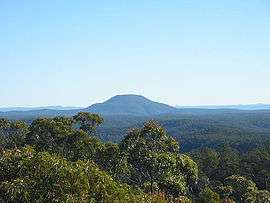Yengo National Park
The Yengo National Park is a protected national park that is located in the Lower Hunter region of New South Wales, in eastern Australia. The 154,328-hectare (381,350-acre) park is situated 85 kilometres (53 mi) northwest of the Sydney central business district, 40 kilometres (25 mi) south of Cessnock, 40 kilometres (25 mi) north of Wisemans Ferry, and 155 kilometres (96 mi) southwest of Newcastle.[1][2]
| Yengo National Park New South Wales | |
|---|---|
IUCN category Ib (wilderness area) | |
 Mount Yengo, or Big Yengo, a 668-metre-high (2,192 ft) mountain, located in the national park. | |
 Yengo National Park | |
| Nearest town or city | Wollombi |
| Coordinates | 33°02′32″S 150°47′10″E |
| Established | 11 March 1988[1] |
| Area | 1,543.28 km2 (595.9 sq mi)[1] |
| Managing authorities | NSW National Parks and Wildlife Service |
| Website | Yengo National Park |
| See also | Protected areas of New South Wales |
The Yengo National Park is one of the eight protected areas that, in 2000, was inscribed to form part of the UNESCO World Heritage–listed Greater Blue Mountains Area.[3] The Yengo National Park is the most north–easterly of the eight protected areas within the World Heritage Site. The national park forms part of the Great Dividing Range.
Features
The NSW National Parks and Wildlife Service (NPWS) opened their depot in Bucketty in 1993 and commenced managing the newly established Yengo National Park. A helipad, known as 'Bucketty International' was established and in 1995 a fire tower was built, following severe fires in the area. In 1999 the NPWS acquired parts of the Crown land that lay between Bucketty and the Yengo National Park. This new area also included the Convict Wall and the amphitheatre used by the community.

The Bucketty community asked NPWS to recognise their custodianship of the place and in early 2000, the community, together with the NPWS, developed a Memorandum of Understanding to jointly manage the site.
Access to Yengo National Park is via Yengo Creek Road off the Great North Road, near Laguna. The park is bounded in the east by the small settlements of Bucketty and Broke; in the north by Wollombi Brook; in the west by the Putty Road, the settlements of Putty and Mellong, and the Mellong Range; and in the south by the Parr State Conservation Area, the settlement of St Albans, Webbs Creek, Mogo Creek, the Hawkesbury River, and the Dharug National Park.[4]
The course of the Macdonald River flows from the northwest of the national park towards the southeast, where it reaches its confluence with the Hawkesbury River.[4]
References
- "Yengo National Park: Park management". Office of Environment and Heritage. Government of New South Wales. Retrieved 3 October 2014.
- "Yengo National Park: How to get there". Office of Environment and Heritage. Government of New South Wales. Retrieved 3 October 2014.
- "Greater Blue Mountains Area". World Heritage List. UNESCO. 2014. Retrieved 31 August 2014.
- "Yengo National Park, Parr State Conservation Area, and Finchley Aboriginal Area: Plan of Management" (PDF). NSW National Parks and Wildlife Service (PDF). Government of New South Wales. 12 January 2009. p. 56. ISBN 978-1-74232-156-1. Retrieved 3 October 2014.
External links
| Wikivoyage has a travel guide for Yengo National Park. |
- "History of the Yengo National Park". Colong Foundation for Wilderness.
- "Yengo National Park, Parr State Conservation Area, and Finchley Aboriginal Area: Plan of Management" (PDF). NSW National Parks and Wildlife Service (PDF). Government of New South Wales. 12 January 2009. ISBN 978-1-74232-156-1.
- "Greater Blue Mountains World Heritage Area: Strategic Plan" (PDF). NSW National Parks and Wildlife Service (PDF). Government of New South Wales. January 2009. ISBN 978-1-74122-960-8.